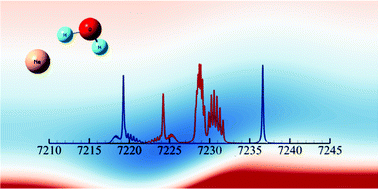Vibrationally excited intermolecular potential energy surfaces and the predicted near infrared overtone (vOH = 2 ← 0) spectra of a H2O–Ne complex†
Abstract
The ab initio intra- and inter-molecular potential energy surfaces (PESs) for the H2O–Ne system that explicitly incorporate the intramolecular overtone state (vOH = 2) of H2O are presented. The electronic structure computations have been carried out at the explicitly correlated coupled cluster theory [CCSD(T)-F12] level with an augmented correlation-consistent triple zeta basis set and an additional bond function. The vibrationally averaged three-dimensional intermolecular potentials for |00+〉, |02+〉, |02−〉 and |11+〉 are obtained analytically by fitting to the multi-dimensional Morse/Long-range potential function form. These fits to 46 980 points have a root-mean-square (RMS) discrepancy of 0.12 cm−1 for interaction energies less than 1000.0 cm−1. With the vibrationally averaged PESs for the H2O–Ne, we employed the combined radial discrete variable representation/angular finite basis representation method and Lanczos algorithm to calculate rovibrational energy levels (J = 0–10, ns ≤ 2). The predicted infrared transitions and intensities of the para- and ortho-H2O–Ne complex are in good agreement with the available experimental data for |02−〉 ← |00+〉, |02+〉 ← |00+〉 transitions. In particular, the RMS discrepancy for |02−〉∑e(000,0) ← |00+〉∑e(101,0), including P and R branch patterns, is only 0.045 cm−1, which is comparable with the experimental values. These results will provide reliable theoretical guidance for the future infrared overtone spectroscopy of clusters.

- This article is part of the themed collection: 2022 PCCP HOT Articles


 Please wait while we load your content...
Please wait while we load your content...